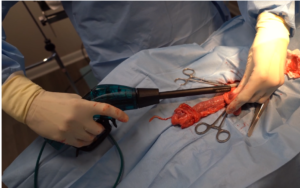Welcome to WordPress. This is your first post. Edit or delete it, then start writing!
Month: October 2024
DVMs, Is Your Vessel Sealer Not “Cutting It”?

Vessel sealers have been used in human medicine for many years and have a myriad of benefits including faster surgery times, less blood loss, a clearer operative field, less tissue trauma/thermal injury and fewer instrument exchanges during the procedure. These benefits are realized because of a vessel sealer’s two primary functions: delivery of intelligent energy combined with transection of tissue using an integrated blade.
How does it work?
Advanced energy devices continually evaluate the tissue in the jaws of the device and optimize the amount of energy delivered to denature proteins and form a sticky coagulum that seals vessels. Delivering too much energy to the tissue can result in excessive eschar, smoke and tissue adherence to the device. Applying too little energy to the tissue may not seal a vessel and will result in bleeding.
A Cut Above the Rest
A true vessel sealing device also offers a concealed blade within the device jaws. This provides integrated transection which allows for fewer surgical maneuvers. Clamp, seal and transect are all reliably completed with one bite of tissue in under 10 seconds. There is no need for additional clamps, multiple seals, or instrument exchanges for scissors.
Vessel sealing with advanced energy and an integrated blade for transection can be a significant enhancement to any veterinarian practice for procedures like spay, neuter, pyometra resection, splenectomy, soft palate resection and amputation. VetOvation offers a wide range of affordable vessel sealing options by way of Applied Medical Voyant and Aesculap Caiman product lines. Please view our product information and videos on www.vetovation.com or contact us at (919) 247-0328.
Video Scope System for Otoscopy/Rhinoscopy and Intubation
[arve url=”https://vimeo.com/1001684787″ description=”Video Scope Systems for otoscopy, rhinoscopy and intubation” /]
Two portable VetOvation video scope systems that can be used for veterinary otoscopy, rhinoscopy and small animal intubation.